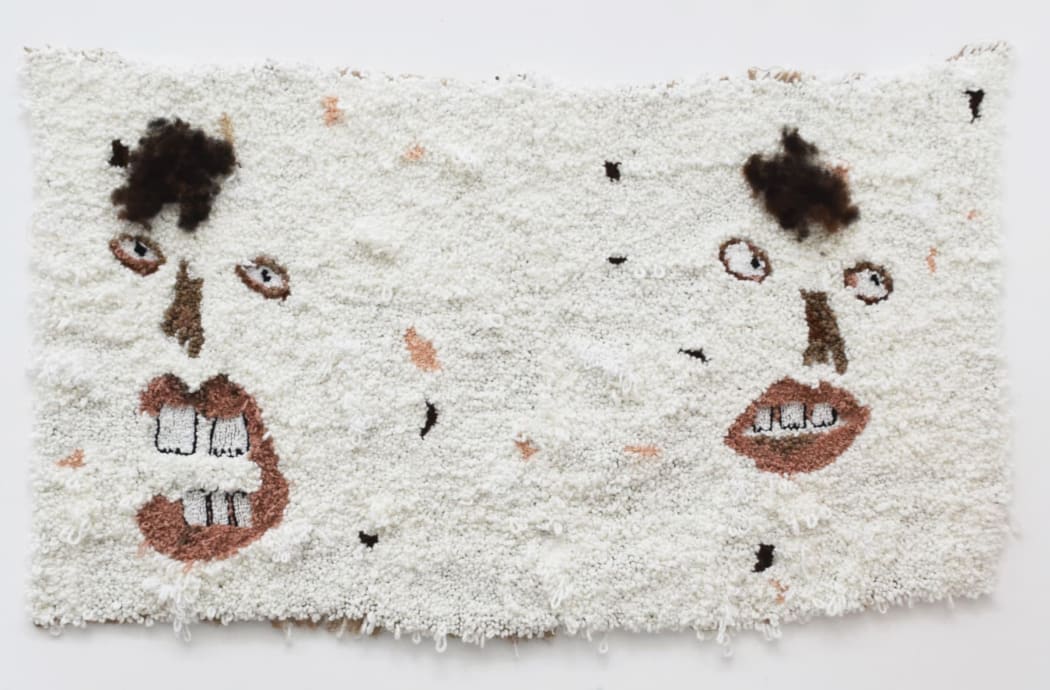
“Ni yn unig” – only us. Titled in Welsh, Anya Paintsil’s first language, Ni yn unig is based on a childhood photograph. The artist and her sister, aged circa seven and five respectively, have been rendered in textiles: not only how they were (“She was quiet; I was loud. I was such an angry kid, and she was this duckling behind me,” says Paintsil), but how they felt themselves to be. Here, the ingredients of two little faces float over a blank background; their Afrocentric features have been exaggerated, hovering amidst the overwhelming whiteness of their childhood environment.
Anya and her sisters grew up in Wrexham, North Wales. There, “we were confused with anyone who wasn’t white – if they were Asian, black, if they wore glasses, if they were a foot taller than me… it didn’t matter. We felt like these homogenous black blobs.” Living with their white mother, and as children of a black father, the artist explains that they came to believe one inherited skin colour from “your dad’s side”; after all, Wrexham offered very little evidence to the contrary. “People told me all the time that I must be adopted. That my mum couldn’t possibly be my mum”, says Paintsil. “For most of our childhood, there was a lot of focus on what made us not white – what made us different”, she explains. “Those differences felt magnified by everybody around us.”
The collision of non-whiteness with their welsh-speaking identities made the artist and her sisters an especial curiosity. “There were some people of colour around, but we went to a Welsh Medium school and associated with the Welsh speaking community more than anybody else. I think I’ve met one other non-white Welsh speaker in my life – just one, who wasn’t related to me,” says Paintsil. “So we were very used to everybody asking, where are you from? Where are you from? And then when you say, here, they’d say – well, no you’re not. You can’t be.”
One of the features that seemed to underscore Paintsil’s otherness as a child was her afro hair. Today, it’s as central to her practice as it was to her identity growing up – as such, in Ni yn unig, locks of the artist’s own are incorporated into the fabric of the piece itself. While hair is regularly used in her other works, the material is most frequently synthetic – weaves, braids, and so on. Depicting herself and her sister, though, called for a personal touch. “I wanted to use my own hair for this, because it’s kind of about me in a lot of ways”, says the artist. Black and mixed-race hair, of course, is politically as well as personally charged. “There is a good and bad hair hierarchy within the community”, she explains. “And I think being a mixed-race person, I'm often expected to have very loose curls, or long hair like my sister – but I have very, very naturally curly hair.”
In Ni yn unig, those curls have been tufted and sewn onto their fabric background, projecting out in a three-dimensional extension of the work’s surface. One patch of hair sits above each face; both are caricatured in line with racist depictions of black people from history as well as the messages Paintsil internalised growing up. “I remember being in primary school, painting a self-portrait. The teacher forced me to paint my face completely jet black – I was so upset. It just ended up being hair and eyes. I must have been about five, but I was already learning how distorted the perceptions of other people were,” she recalls. “Looking at Jim Crow era drawings of black people in America, I wanted a lot of focus on the eyes, nose, mouth. I wanted to look at what made us different, but through the lens of how other people saw us.”
Paintsil works with textiles, leveraging those formative lenses into her own repertoire on an intimate scale. Engaging with the medium as an historically female one, her iterations interrogate questions of class as well as gender. “I wanted to look at typically industrial textiles, textiles that are associated with utility or a strong kind of working-class background as opposed to just being decorative,” she explains. “I wanted to create something that comes from my lineage, my heritage.” Part of Paintsil’s family were farmers, and her particular techniques were learnt long before she started art school: “My grandma taught me how to do latch hooking, rug making, rag rugging”, she says; “stuff that really was useful. Things that she’d needed to do herself when she was younger.”
The process of punch needling, as in Ni yn unig, is laborious; pulling fibres through hessian weaves piece by piece, requires not only technical rigour but swathes of time too. “That aspect of labour was important to me because I thought it meant that my work couldn’t be dismissed. That it was inarguably ‘art’, if you know what I mean,” muses Paintsil. Certainly, her practice propels mediums which haven’t been historically lauded as part of the Western canon into fine art’s orbit; “these are techniques that are technical, and hard, and interesting. Hair, rug making… you can do so many beautiful things with them.”
As mediums traditionally relegated to communities outside the staunch cultural apex of white, male, upper class, Paintsil reframes rugging (working class, female) and afro hairdressing (non-white, female) beyond their perceived domesticity and insists on their prominence in new spaces. Material, unfurling novel spheres of meaning – after all, difference demands a status quo to be defined against. Across both medium and message, Paintsil fuses identity and belonging while troubling their mutual echo, reinforced by every interaction with the sea beyond one’s bubble. From inside that bubble, of course, it’s the sea that looks strange. For Paintsil and her sisters growing up, that was a small crowd indeed: only us.
By Emily Watkins
